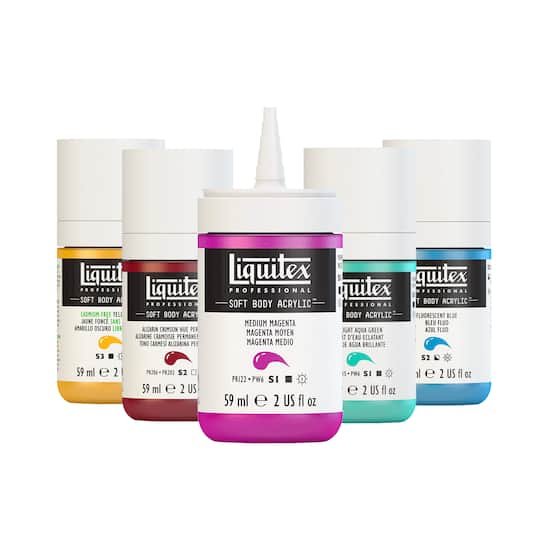A Complete Guide to Liquitex Acrylic Paints: Soft Body, Heavy Body, and More
Meet Liquitex
When it comes to acrylic painting, Liquitex is a name that stands out. Known for its high-quality pigments, formulas, and extensive range of products, Liquitex has been a go-to brand for artists of all levels for decades. Whether you’re a beginner experimenting with your canvas or a seasoned professional looking for reliable, consistent results, Liquitex has something to offer. In this guide, we’ll break down the different types of Liquitex acrylics, their unique properties, and the various mediums that can help you refine your painting techniques.

Liquitex Soft Body Acrylics
What Are Soft Body Acrylics?
Soft Body acrylics have a smooth, creamy consistency that flows easily, making them perfect for detailed brushwork, glazing, and even airbrushing. Unlike heavy body paints, which hold their shape, Soft Body acrylics have a more fluid texture and easier blend-ability, but they still pack a punch in terms of pigment concentration.
Best Uses for Soft Body Acrylics
- Detail Work: The fluid consistency makes it easy to intricate details and fine lines.
- Glazing: When mixed with glazing mediums, Soft Body acrylics produce luminous, transparent layers.
- Pouring & Fluid Art: Their smooth nature allows them to be used for paint pouring without needing excessive thinning.
- Airbrushing: With the right dilution, Soft Body acrylics work well in airbrush applications.
Pros & Cons
Pros:
- High pigment load with a smooth consistency
- Versatile for different techniques, from glazing to airbrushing
- Easier blending compared to Heavy Body acrylics
- Compatible with all Liquitex mediums
Cons:
- Less texture and sculpting ability
- May require multiple layers for full coverage

Liquitex Heavy Body Acrylics
What Are Heavy Body Acrylics?
Heavy Body acrylics have a thick, buttery consistency, making them ideal for bold, textured strokes and impasto techniques. These paints retain brushstrokes and knife marks, giving artists a level of texture similar to oil paints but with the fast-drying benefits of acrylics.
Best Uses for Heavy Body Acrylics
- Impasto Techniques: Great for thick applications and creating texture.
- Palette Knife Painting: Holds shape well when applied with a knife.
- Layering: Due to their opacity and thickness, they’re great for layering colors without muddying.
- Mixing with Mediums: Blends beautifully with gels and modeling pastes for additional texture.
Pros & Cons
Pros:
- High viscosity for thick, textured applications
- Excellent color vibrancy and opacity
- Holds brushstrokes and palette knife marks well
- Can be used for both traditional painting and mixed media
Cons:
- Dries quickly, making blending more difficult
- Requires a palette knife or thick brush for best results

Liquitex Slow-Drying Mediums
Why Use Slow-Drying Mediums?
Acrylics dry notoriously fast, which can be frustrating when trying to blend or achieve soft gradients. Liquitex offers several slow-drying mediums that extend drying time without compromising the quality of the paint.
Types of Slow-Drying Mediums
- Liquitex Slow-Dri Fluid Retarder: A liquid additive that increases open time without altering paint consistency.
- Liquitex Slow-Dri Gel Medium: Adds a bit of body to the paint while slowing drying time, making it great for blending and extended working time.
- Liquitex Palette Wetting Spray: Helps keep paint on the palette from drying too quickly.
Best Uses for Slow-Drying Mediums
- Blending & Gradient Work: Extends working time, allowing for smooth transitions between colors.
- Wet-on-Wet Techniques: Gives more time to work before the paint sets.
- Minimizing Brush Marks: Helps create soft, even finishes in paintings.
Pros & Cons
Pros:
- Allows for more flexibility and control
- Prevents acrylics from drying too quickly
- Useful for large-scale paintings
Cons:
- Can dilute color intensity if overused
- Adds drying time, which may not be ideal for fast-paced projects
Additional Liquitex Products & Accessories
Apart from their paint lines, Liquitex also offers a range of complementary products:
- Liquitex Professional Acrylic Ink: A highly fluid, intensely pigmented acrylic ink for calligraphy, airbrushing, and fine details.
- Liquitex Basics: A student-grade alternative that offers good quality at a more affordable price.
- Liquitex Varnishes: Available in gloss, matte, and satin finishes to protect artwork.
- Liquitex Gesso: A primer that prepares surfaces for painting.
Which Liquitex Acrylic Is Right for You?
Choosing the right acrylic paint depends on your style and technique. Here’s a quick guide:
- If you want thick, textured brushstrokes: Go for Heavy Body acrylics.
- If you prefer smooth, fluid applications: Choose Soft Body acrylics.
- If you need more blending time: Incorporate Slow-Dri mediums into your workflow.
- If you love fine details or airbrushing: Try Liquitex Professional Acrylic Ink.
Conclusion
Liquitex has built its reputation on innovation and high-quality acrylics that cater to artists of all styles. Whether you’re working on a large impasto piece, a detailed portrait, or an experimental mixed-media project, Liquitex offers a variety of products to suit your needs. Understanding the differences between Soft Body and Heavy Body acrylics, along with utilizing slow-drying mediums when necessary, can help you achieve the best results in your work.
No matter where you are on your artistic journey, having the right materials can make all the difference. If you haven’t tried Liquitex yet, it might be time to pick up a few tubes and start experimenting!
Chromatic Palette is supported by its audience. When you buy through links on our site, we may earn an affiliate commission.